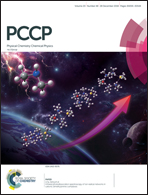Reply to the ‘Comment on “Investigations on HONO formation from photolysis of adsorbed HNO3 on quartz glass surfaces”’ by M. N. Sullivan, L. T. Chu and L. Zhu, Phys. Chem. Chem. Phys., 2018, 20, DOI: 10.1039/C8CP04497J
Abstract
In their comment to our recent paper about low HONO and NO2 formation by photolysis of adsorbed HNO3 Sullivan et al. confirmed their former results of HNO3 adsorption on silica under dry conditions using a quartz crystal microbalance. The authors concluded that the differences between their results and our conclusions are caused by the different experimental conditions, i.e. adsorption under very dry conditions compared to our experiments at 50% r.h. While we agree that adsorption of the highly water soluble HNO3 will strongly depend on humidity, there is still the conflict in the photolysis frequency of adsorbed HNO3 under atmospheric conditions to which the authors referred in their previous publications (see their atmospheric implication sections) and to which also our paper refers. If their results on both the adsorption cross sections of HNO3 (two to three orders of magnitude larger compared to the gas phase) and the quantum yield for NO2 formation (close to unity) are applicable under conditions prevailing in the atmosphere, then the photolytic lifetime of HNO3 on surfaces would be only ∼5 min for atmospheric solar flux (0° SZA), which is highly unlikely.


 Please wait while we load your content...
Please wait while we load your content...